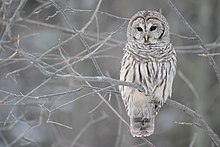Barred owl
| Barred owl | |
|---|---|
 |
|
| Scientific classification | |
| Kingdom: | Animalia |
| Phylum: | Chordata |
| Class: | Aves |
| Order: | Strigiformes |
| Family: | Strigidae |
| Genus: | Strix |
| Species: | S. varia |
| Binomial name | |
|
Strix varia Barton, 1799 |
|
| Subspecies | |
|
|
| Synonyms | |
|
Syrnium varium |
|
Syrnium varium
The barred owl (Strix varia) is a typical owl native to eastern North America. Adults are large, and are brown to grey with barring on the chest. Barred owls have expanded their range to the west coast of the United States, where they are considered invasive. Mature forests are their preferred habitat, but they are also found in open woodland areas. Their diet consists mainly of small mammals, but they are also known to prey upon other small animals such as reptiles and amphibians.
The adult is 40–63 cm (16–25 in) long with a 96–125 cm (38–49 in) wingspan. Weight in this species is 500 to 1,050 g (1.10 to 2.31 lb). It has a pale face with dark rings around the eyes, a yellow beak and brown eyes. It is the only typical owl of the eastern United States which has brown eyes; all others have yellow eyes. The upper parts are mottled gray-brown. The underparts are light with markings; the chest is barred horizontally while the belly is streaked vertically (hence its name "barred owl"). The legs and feet are covered in feathers up to the talons. The head is round and lacks ear tufts.
Outside of the closely related spotted owl, this streaky, dark-eyed, chunky-looking owl is unlikely to be confused over most of the range. The spotted owl is similar in appearance, but is slightly smaller and has spots rather than streaks down the underside. The great horned owl is much larger, has ear tufts, and has yellow eyes.
The barred owl is distributed throughout most of the eastern United States, as well as much of southern Canada. Their range extends to British Columbia, and from there they have moved into the northwest United States. In the states of Washington, Oregon, and California; barred owls have engulfed the native range of the northern spotted owl, which they now compete with.
The historical lack of trees in the Great Plains acted as a barrier to the range expansion and recent increases in forests broke down this barrier. Increases in forest distribution along the Missouri River and its tributaries provided barred owls with sufficient foraging habitat, protection from the weather, and concealment from avian predators to allow barred owls to move westward. Decades later, increases in forests in the northern Great Plains allowed them to connect their eastern and western distributions across southern Canada. These increases in forests were caused by European settlers (American settlers) excluding fires historically set by Native Americans, suppressing fires and planting trees; they were caused, to lesser degrees, by European settlers extirpating bison (Bison bison), overhunting elk (Cervus elaphus) and deer (Odocoileus spp.) and, in some areas, extirpating beaver (Castor canadensis) and replacing native ungulates with livestock. Increase in trees in the Great Plains from fire suppression or tree planting is considered a main cause of the range expansions of many other species of birds including western kingbird (Tyrannus verticalis),eastern phoebe (Sayornis phoebe),eastern bluebird (Sialia sialis),blue jay (Cyanocitta cristata),brown thrasher (Toxostoma rufum),red-tailed hawk (Buteo jamaicensis), and American crow (Corvus brachyrhynchus).
...
Wikipedia

